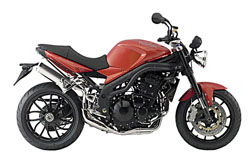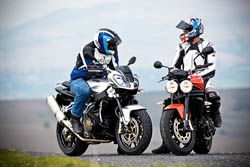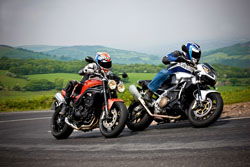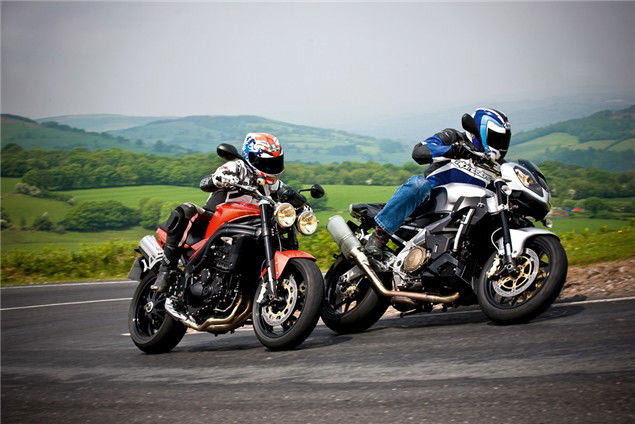Road test: Aprilia Tuono vs. Triumph Speed Triple
Last year Aprilia's Tuono and Triumph's Speed Triple topped the street bike sales charts in the UK. What makes these bikes catch rider's imaginations

height=10> | |
     Aprilia Tuono Launch VideoFor all their might and development budgets there’s something the Japanese manufacturers are unable to pump into their bikes at will, and that’s soul. It doesn’t matter if it has toe-curling bhp, suspension that can be adjusted in a multitude of directions or mind-bending futuristic design, if it lacks that certain X-factor it will leave the public cold. Sure, in certain classes you can negate the whole soul thing and sell on performance alone, but for some bikes this simply isn’t enough, which is where the Japanese struggle. Last year in the UK despite Kawasaki launching the new Z1000, Suzuki the B-King and Yamaha refreshing the look of the FZ1 with more aggressive colours, the top selling street bikes were Triumph’s Speed Triple and Aprilia’s Tuono. Two old warhorses of the street bike class. So what is it that these bikes have that makes them so special? To be fair describing the Triumph as a warhorse is a bit harsh. The Speed Triple itself dates back to almost the beginning of time (well, 1994) but the latest look, with stubby twin pipes, was debuted in 2005. It’s just that it feels like it’s been around for ages because it’s not that radical. Look at the current, slightly modified with new wheels and subtle tweaks ‘08 bike and it’s instantly recognisable as a Speed Triple thanks to its twin headlights and chunky, rounded styling. A far cry from the likes of the Z1000 or Honda’s new CB1000R with their almost desperate-to-be-different style. Then there is Aprilia’s Tuono, a bike that has steadfastly refused to change its look unless absolutely necessary. The only time this bike has been given a facelift was when its donor bike, the RSV-R, changed in 2003. For 2004 we saw a new sharper Tuono, but that was the last time anything major happened. Well, if you take the sensible step of forgetting about the hideous gold frames of the Factory bikes. So what is the key to these bike’s success in the UK? The simple fact is that both of them come brimming with soul and character, and in a tough financial climate where buying a bike is such a major decision to most riders it’s this factor that is enough to sway a decision. Both the Tuono and Speed Triple feel like bikes that will be a part of your life for longer than just a few years, something that can’t be said about the slightly disposable feeling you get with the Japanese competition. But they do it in very different ways. It’s easy to fall for the subtle charms of the Triumph. Despite the aggressive styling and hard man image of the street bike the Speed Triple is, in actual fact, anything but hard. It’s a great big softie that is trying its best to put up an intimidating image, but actually just wants to be your mate. Sit on it and the seat gently gives to offer a lovely padded ride and while the new chunky motocross bars try to intimidate with their macho-ness, the wide and relaxed stance soon gives their true feelings away. Even the pegs are set at a low height. Triumph understands its market, and it realises that despite the aggressive image of the street bike, owners like their ride to be more relaxed. Which is where the engine comes in. If the comfort and style of the Speed Triple doesn’t win you over the motor will. There is something very charming about the triple engine, not only in feeling but also in sound. Out of any of the current engines on the market it’s by far and away the easiest to live with. Where with inline fours you are often left wanting a bit more bottom end and twins irritate with their abrupt power delivery the triple does none of this. It may not be the fastest out there, but due to an almost flat torque curve there is always power and drive on hand, without the need to search for it by changing down a few gears. It’s a lazy man’s motor that has an intoxicating roar on acceleration and fantastic burble on over-run. Add to this near perfect fuel injection and the slightly clunky and agricultural gearbox is quickly forgotten about. In fact there is little that irritates about the Triumph’s engine, it feels, and indeed is, quite simply a very well sorted motor with few rough edges that easily be forgiven and put down as character. And it’s the same with the handling. It’s not the sharpest out there, but it’s certainly the easiest. How often do you really want to go barrelling down a twisty road at a million miles an hour? Not that often. If we are all honest with ourselves we would rather swap a gentle, responsive and well damped ride for a wrist-battering, twitching roller coaster any day of the week. Which is what you get with the Speed Triple. Bumpy roads don’t upset the Triumph’s forks, they are set on the soft side to deal with the undulations of the British roads. And while this might give a slightly spongy ride when you slip into banzai mode, it’s far more pleasant for 99% of the time when you aren’t on lap-record pace. This isn’t to say, however, that the Speed Triple isn’t capable of upping the pace. A large part of the Triumph’s charm is that it’s more that up for playing the fool, if you so wish. Firm the suspension a bit and the Triple’s excellent chassis and responsive handling is upped a notch. Flick the clutch in second and the Triumph becomes one of the easiest bikes to wheelie you can buy and slam on the new uprated brakes and it stops as well as most sportsbikes. All the sporting potential is there in the Speed Triple, it just doesn’t choose to show it all the time, unlike the Tuono. The naked Aprilia has always been the hooligan’s choice. It’s a street fighting bad boy with attitude, which is what sets it aside from the Japanese. None of the ‘big four’ could build a Tuono, it’s too edgy. Where the Triumph is a lesson in subtlety, the Tuono is a sledgehammer of a bike. Which is why owners love them. The Tuono has character thanks to the fact it feels like it doesn’t give a damn if you like it or not, it is what it is and if you don’t like it doesn’t care. Initially the riding position feels all-wrong. You’re perched above the bike with the ground somewhere miles below. Unlike the Triumph that you nestle into the Aprilia sticks you on top, almost separating itself from the rider and creating two distinct elements – rider and bike. This isn’t a bike that wants to be tactile like the Triumph. On the go the Tuono remains hard work. The V-twin engine is the same as the one in the RSV-R and as such is seriously fast. Open the throttle and the power is delivered instantly and with almost ferocious response. Get the wrong gear, or let the revs drop too much, and the motor shudders and vibrates its annoyance at your blunder. Get it right and it buzzes its pleasure while driving forward with indecent haste. On a straight road the Tuono would murder the Triumph, not to mention most other bikes, when it comes to acceleration and straight line performance, as long as you can hold on. As you would expect from a bike that is little more than a stripped down sportsbike the Tuono’s handling is razor sharp. Down less than perfectly smooth roads the front end can start to shake a bit and the suspension feels rock solid, but get to the corners and the Aprilia drops on its side like the sportsbike that it is, all be it with a slightly top heavy feeling due to the rider’s weight being carried so high on the bike. It’s not at all uncommon to see Tuonos on trackdays, and generally right at the business end of the group, dishing it out to the faired pretenders. The problem with this is that the UK roads are often anything but perfectly smooth, and riding the Tuono when you aren’t wanting to go mad is hard work, it’s the complete antithesis of the Triumph. From the pathetic steering lock to the heavy clutch to the harsh suspension to the slightly too brutal brakes everything about the Aprilia is geared to performance, and nothing else. It doesn’t want to gently take your hand and guide you on a trip, it wants to rip it off and run away with it! I always get the feeling that to ride a Tuono you have to be a real man, prepared to fight it every step of the way, where as on the Triumph you can have an off day and not be left feeling inadequate. But that is a big part of these bikes, they make you feel something, give you an emotion, that’s their soul. The Tuono is thrilling, hard work and intimidating to ride. The Triumph is easy, relaxing and gentle. Both bikes are memorable to ride, which is something that I have to say I struggle with on with the Japanese street bikes. It always feels like they are trying to be something they are not, having characted forced in them by marketing people and ending up confused about what they are. Both the Aprilia and Tuono have built themselves a niche, and potential owners know exactly what they are getting. This isn’t something you get with a Japanese street bike and is why in a time where owners are wanting more from their bikes to justify the expense than simple transport bikes with soul will always sell better than those without. |

For all their might and development budgets there’s something the Japanese manufacturers are unable to pump into their bikes at will, and that’s soul.
It doesn’t matter if it has toe-curling bhp, suspension that can be adjusted in a multitude of directions or mind-bending futuristic design, if it lacks that certain X-factor it will leave the public cold. Sure, in certain classes you can negate the whole soul thing and sell on performance alone, but for some bikes this simply isn’t enough, which is where the Japanese struggle.
Last year in the UK despite Kawasaki launching the new Z1000, Suzuki the B-King and Yamaha refreshing the look of the FZ1 with more aggressive colours, the top selling street bikes were Triumph’s Speed Triple and Aprilia’s Tuono. Two old warhorses of the street bike class. So what is it that these bikes have that makes them so special?
To be fair describing the Triumph as a warhorse is a bit harsh. The Speed Triple itself dates back to almost the beginning of time (well, 1994) but the latest look, with stubby twin pipes, was debuted in 2005. It’s just that it feels like it’s been around for ages because it’s not that radical.
Look at the current, slightly modified with new wheels and subtle tweaks ‘08 bike and it’s instantly recognisable as a Speed Triple thanks to its twin headlights and chunky, rounded styling. A far cry from the likes of the Z1000 or Honda’s new CB1000R with their almost desperate-to-be-different style.
Then there is Aprilia’s Tuono, a bike that has steadfastly refused to change its look unless absolutely necessary. The only time this bike has been given a facelift was when its donor bike, the RSV-R, changed in 2003.
For 2004 we saw a new sharper Tuono, but that was the last time anything major happened. Well, if you take the sensible step of forgetting about the hideous gold frames of the Factory bikes. So what is the key to these bike’s success in the UK?
The simple fact is that both of them come brimming with soul and character, and in a tough financial climate where buying a bike is such a major decision to most riders it’s this factor that is enough to sway a decision. Both the Tuono and Speed Triple feel like bikes that will be a part of your life for longer than just a few years, something that can’t be said about the slightly disposable feeling you get with the Japanese competition. But they do it in very different ways.

